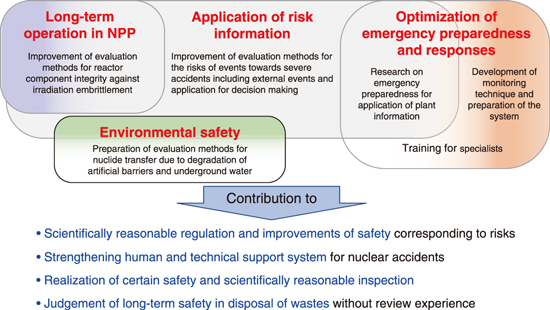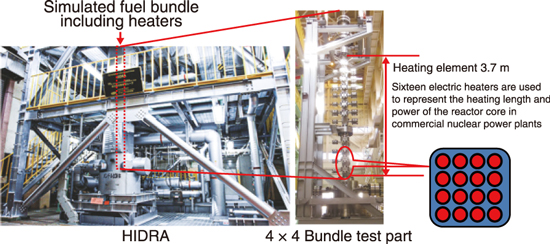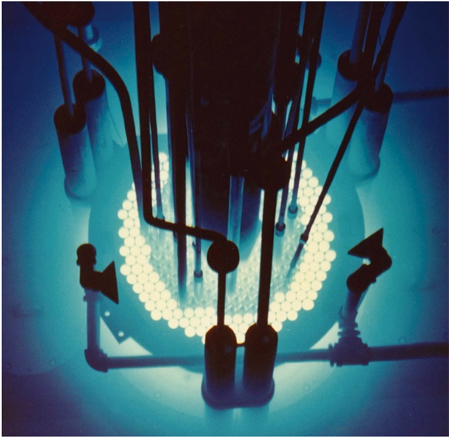
Fig.2-1 Activities at the Sector of Nuclear Safety Research and Emergency Preparedness

Fig.2-2 High-pressure thermal-hydraulic loop (HIDRA)

Fig.2-3 Nuclear Safety Research Reactor (NSRR)
The Sector of Nuclear Safety Research and Emergency Preparedness has performed safety research in accordance with the lessons learned from the accident at the TEPCO’s Fukushima Daiichi NPS (1F), as well as response to emergency situations as a designated public institution assigned in the Disaster Countermeasures Basic Act and training for personnel engaging nuclear emergency preparedness and responses in normal times. As shown in Fig.2-1, pillars of research activities have been prioritized, specifically, evaluation of the risks toward severe accidents beyond the design basis, nuclear emergency preparedness for appropriate and rapid response to nuclear accidents, research for long-term operation in nuclear power plants on neutron irradiation embrittlement of reactor pressure vessels using materials harvested from commercial reactors, and environmental safety research on disposal of nuclear wastes from 1F and intermediate depth disposal. Through these activities, we have provided technical support for nuclear regulatory administration and have contributed to strengthening of nuclear emergency preparedness and responses in related administrative agencies and local public bodies.
The safety research in Japan Atomic Energy Agency (JAEA) is featured by large-scale facilities where various accident conditions can be simulated. For example, the high-pressure thermal-hydraulic loop shown in Fig.2-2 has been constructed and used to develop sophisticated techniques to evaluate core heat transfer. The Nuclear Safety Research Reactor, shown in Fig.2-3, has been used to investigate the fuel failure limit and the effect of fuel failure on the nuclear reactor during a reactivity-initiated accident, which is a design-basis event. In addition, studies on ultra-trace analysis of nuclear materials for nuclear safeguards have also been performed. Furthermore, JAEA has acted as the operating agent in the OECD/NEA project on the analysis of information from the accident at 1F.
In the field of emergency preparedness and responses, the effectiveness of sheltering as a protective action has been evaluated to improve protection strategy. Moreover, techniques to integrate data obtained by different monitoring methods and investigate radioactivity distributions in coastal regions around 1F are under development. Background radioactivity monitoring of domestic nuclear power plants is continuously carried out in preparation for nuclear emergencies.
This chapter presents the results of the following recent research activities: evaluation of the risks toward core damage due to loss of safety function after internal flooding from ruptured pipes in a nuclear facility (Topic 2-1); experimental and numerical research on the flow in a containment vessel during a severe accident using a large-scale experimental facility (Topic 2-2); prediction of fuel debris form for the assessment of debris coolability in a severe accident (Topic 2-3); assessment of the sheltering effectiveness in Japanese houses in nuclear accidents (Topic 2-4); evaluation of failure probability of aged piping system in nuclear facilities against seismic ground motion (Topic 2-5); and, evaluation of exposure dose during treatment of asbestos waste arising from decommissioning of nuclear power plants (Topic 2-6).
The other topic related to 1F-accident, improvement of detection accuracy when unmanned helicopters measure the contamination status of radioactive materials released by the 1F-accident (Topic 1-15) was also detailed in Chapter 1.